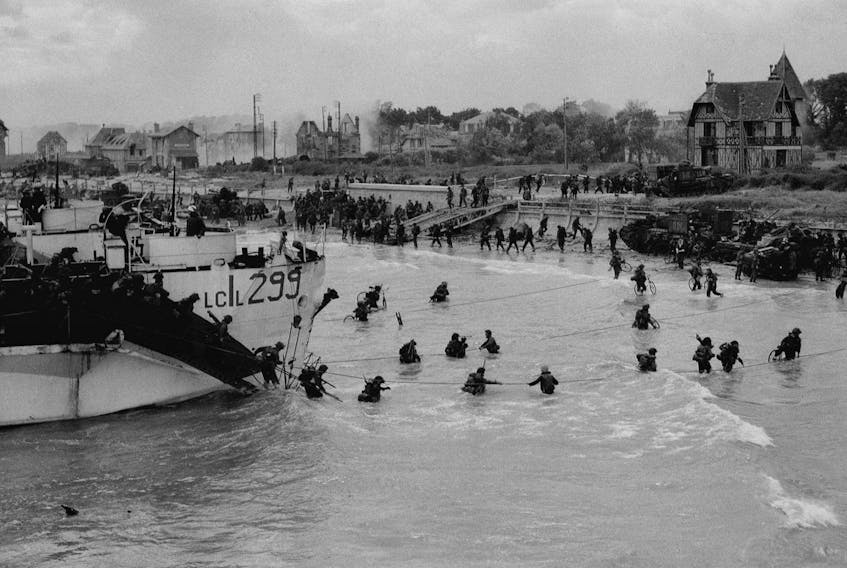EDITOR’S NOTE: The Chronicle Herald and SaltWire Network begin a four-day series on Wednesday, commemorating the 75th anniversary of D-Day. Hundreds of soldiers from Atlantic Canada took part in the invasion and we tell some of their stories.
I have never done anything physically courageous: no subduing an airplane hijacker, no standing resolutely in a meadow as a grizzly bear rears up on its two hind legs.
Since I have never been a first responder I have never taken a big gulp of oxygen before running with purpose into a burning building.
In the same way, having never served my country, I have no inkling what it was like for the young men from the North Nova Scotia Highlanders, the Sherbrooke Fusiliers or the Regina Rifles who, on this day 75 years ago, cast an eye one last time over maps, photos and three-dimensional models of the beaches of Normandy, where a dictator’s guns awaited.
There would have been no sleep as the hours grew short. The stomachs would have churned, the bowels spasmed as the cramped landing craft bound, through rough chop, for Juno Beach.
In our D-Day series in the days ahead, you will read, in their own words, what some of the men who were there felt that fateful day.
But you can also look at an amazing film clip, two minutes and eight seconds long, shot on some long-ago hand-held camera of the men of No. 3 Platoon, A Company, from New Brunswick’s North Shore Regiment in the seconds before they disembarked from the landing craft and into legend.
Back in January, in this space, I wrote about the clip, and about one of the men visible in it, whose profile has been immortalized on the Canadian mint’s new 2019 Proof Silver Dollar commemorating the 75th anniversary of D-Day.
Monday, I had another look at it, because I wanted to see once again the young men from the farms, fishing villages, mill towns and even a few cities, who had never, perhaps, pulled a trigger before, but who felt the call of duty, or adventure, or something else that led them to that place on that day.
In the clip, while the craft shuttling them from ship to beach nears land, the men lift their camouflage-bedecked helmets for quick glances, as the French rooftops appear and recede from view.
The door swings open, revealing the beach littered with German tetrahedral obstacles, where Canadian bodies will soon lie.
One-by-one the men, some of them carrying ladders, some hitching their rifles to their shoulders in the hope of keeping them dry, disembark.
The German bullets flew like hail as they exited the gate, rendering the restraint with which they left the craft breathtaking.
One man’s legs do seem to buckle, making him briefly lose his balance. But they keep going, one after the other, as the first of the 41 soldiers viewable in the clip, scramble onto the beach.
On the first day of the invasion, 33 of the regiment’s 756 members died right there on the beach.
Pte. George Baker, who appears at about the 45-second mark in the film, was not one of them.
At about a minute in, you briefly see the right side of his face: the John Barrymore nose that allowed his daughter to identify him in the clip all those years later, the eyes, visible only in outline on the grainy film.
He was, as I understand it, only 20 at the time, but the garb of warfare makes him seem older, although that may just be me, imposing a narrative since I know what will happen when he steps through that gate.
Back in Brooklyn, N.S., where he lived out the rest of his life, Baker didn’t say much at all about the action he saw, the shrapnel wound he suffered, or the brothers he lost in the Battle of Normandy.
His daughter made Baker sound recalcitrant, maybe not the world’s greatest company.
None of which remotely matters to me, when I look at him standing there, readying to do something that few of us know for certain that we would be able to do.
This, I have heard said, is the thing about courage: that it is not the absence of fear, but the triumph over it.
In my comfortable 21st century life in this wonderful city, in this country of delights, I may never find out the truth of those words.
I’m betting that George Baker, a kid from rural Nova Scotia, had little idea either.
The nature of courage surely didn’t even cross his mind when he decided to go fight Hitler. He may have just walked out the door one day and made his way to the nearest enlistment station.
Have a look at the video and you will see him, on that grey morning, 75 years ago.
What he was thinking as his heart pounded and his pulse raced we will never know.
All we do know, in fact, is this: that after having some sort of exchange with the soldier behind him, Baker turned around, and, for all of us, stepped unto the breach.
D-DAY AT 75: Remembering the heroes and sacrifices of Atlantic Canada:
- VIDEO: The road to D-Day
- Why a school in France is named for a Pictou soldier
- U-boat hunter Roderick Deon returns to Juno Beach for D-Day
- Sound of gunfire rang in P.E.I. soldier’s ears
- North Nova Scotia Highlanders at the sharp end of D-Day invasion
- STORY MAP: Follow the D-Day experience of the North Nova Scotia Highlanders
- 12 North Nova Scotia Highlanders murdered at Abbaye d’Ardenne
- ‘It was noisy as the devil,’ says St. John’s torpedo man
- 59th Newfoundland Heavy Regiment was eager to do its part
- A P.E.I. dispatcher’s long, uncertain journey to Normandy
- LAURENT LE PIERRÈS: D-Day invasion was best birthday present for my Dad
- ‘Sight of our boys being blown up ... wouldn’t leave my mind:’ Bedford veteran, author
- Dartmouth veteran's first combat mission was D-Day invasion
- Halifax air gunner had bird’s-eye view of D-Day
- ‘We had everything fired at us but the galley sink’: Yarmouth County veterans share war and D-Day memories
- New Waterford veteran has lived good life after surviving D-Day invasion
- JOHN DeMONT: An old film clip of D-Day shows the nature of courage
- D-Day landing map’s origins a mystery to army museum historians









